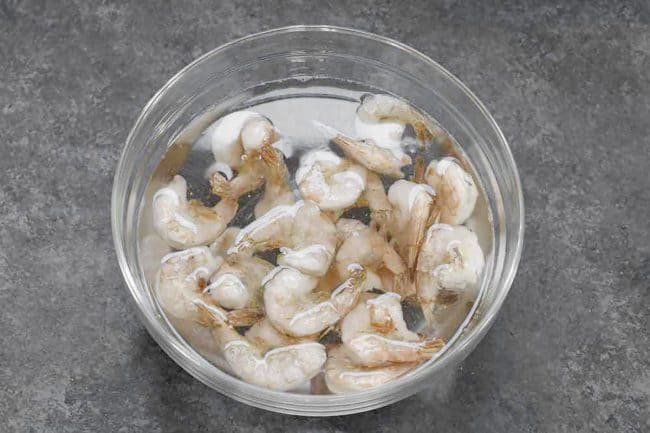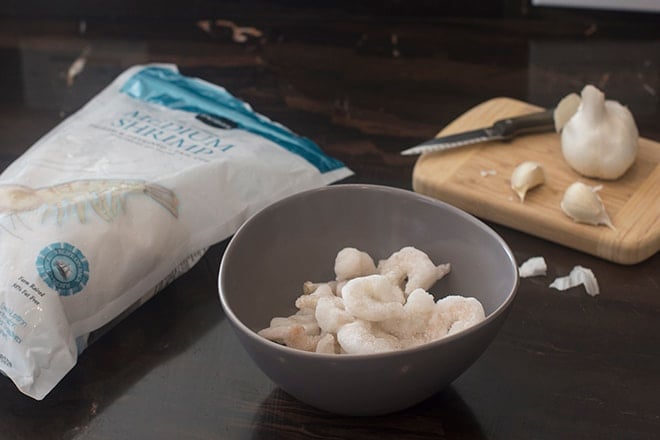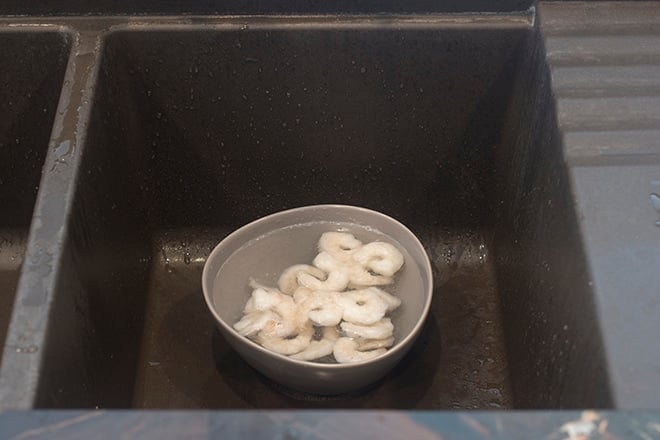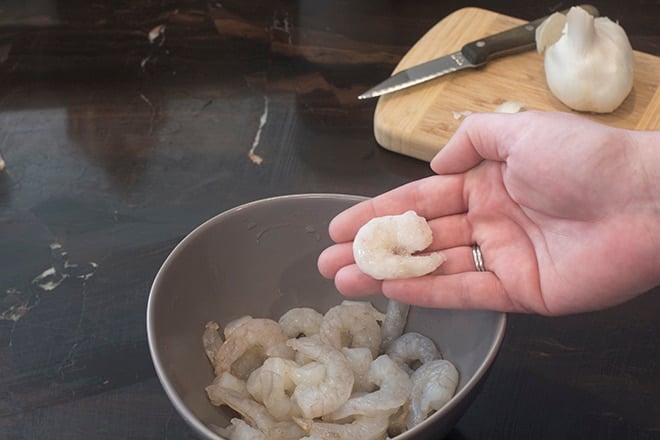Shrimp are often frozen right on the boat after being caught. This is the best way to get them to you fresh and tasty. You only need to let them thaw for a few minutes before you can start cooking them in your favorite shrimp recipes.
But keep in mind that you can cook shrimp from frozen and they will still taste great if you’re in a hurry. Weeknight dinners are saved! If you still want to thaw them before cooking though, the info is below.
Shrimp is a delicious and versatile seafood that freezes exceptionally well. Keeping bags of frozen shrimp on hand provides easy access to a quick protein source for stir fries, pastas, tacos and more. But before you can cook up that frozen shrimp, it needs to be safely thawed. So how long does it actually take for frozen shrimp to thaw completely?
The thawing time can range from as little as 10 minutes up to overnight depending on the method you use. Proper thawing ensures the shrimp thaws evenly for the best texture when cooked. Thawing too quickly or improperly can lead to uneven cooking or potential bacterial growth.
Read on for a detailed guide to thawing times for frozen shrimp and the best practices for safe, effective thawing.
Factors That Impact Thawing Time
Several key factors impact the time it takes to thaw frozen shrimp:
-
Size of the shrimp – Smaller shrimp thaw faster than jumbo varieties Pieces also thaw quicker than whole shrimp
-
Thickness of freezing – Thinner frozen bags or containers thaw faster than very thick blocks.
-
Amount being thawed – A few shrimp thaw faster than multiple pounds.
-
Thawing method – The technique used significantly impacts thawing time.
-
Type of packaging – Material like plastic versus paper affects thaw rate.
-
Cooking method – If cooking frozen, the preparation method will determine time needed.
Thawing Time by Method
There are several methods for safely thawing frozen shrimp Here are approximate thawing times for 1 pound of average-sized frozen shrimp using various techniques
Refrigerator Thawing
- Thawing shrimp in the refrigerator overnight is the slowest but safest method.
- For a 1 pound bag, allow 12-24 hours in the refrigerator.
- Place wrapped shrimp in a bowl or pan to contain drips as it slowly thaws.
Cold Water Submersion
- Submerging sealed shrimp in cold water leads to moderately fast thawing.
- 1 pound of shrimp will thaw in 30-60 minutes when submerged.
- Use a bowl and plate to keep shrimp fully immersed in cold water.
Microwave Thawing
- Microwaving is the fastest thawing technique and takes just minutes.
- For a pound of shrimp, thaw at 30 second intervals, checking often.
- Use microwave-safe container and cold water to cover shrimp.
Key Tips for Safe, Effective Thawing
Follow these best practices when thawing frozen shrimp:
-
Only thaw as much shrimp as you plan to cook immediately. Do not refreeze thawed shrimp.
-
Keep raw shrimp chilled at 40°F or below during thawing to prevent bacterial growth.
-
Monitor closely and frequently test during thawing to prevent over-thawing or cooking.
-
Submerge in cold water or use the microwave to quickly thaw just before cooking.
-
Cook thawed shrimp within 1-2 days for best quality and food safety. Discard if left too long.
-
Rinse thawed shrimp in cold water and pat dry with paper towels before cooking.
Can You Cook Frozen Shrimp Without Thawing?
Cooking shrimp directly from frozen is possible with certain preparation methods. But it typically takes about 50% longer to cook than thawed shrimp.
Here are effective ways to cook frozen shrimp without thawing first:
-
Boiling – Add the frozen shrimp directly to boiling liquid and increase cooking time.
-
Grilling – Defrost just 2-3 minutes first before grilling for even cooking.
-
Stir Frying – Quickly sauté over high heat, adding extra oil and tossing constantly.
-
Baking – Bake frozen shrimp straight on a sheet pan but extend cook time.
Thawing Specific Cuts and Portions
For quicker and more even thawing, the type of shrimp you buy matters. Here are some thawing time differences:
-
Shrimp tails – Thaw faster than whole, shell-on shrimp.
-
Peeled, deveined shrimp – Thaw most quickly without shells.
-
Smaller shrimp – Thaw faster than large jumbo shrimp.
-
Shrimp pieces – Chopped or diced shrimp thaws fastest.
-
Butterflied shrimp – Thaw faster than whole due to more surface area.
Adjust thawing techniques and times based on the specific type and cut of your frozen shrimp.
Troubleshooting Unevenly Thawed Shrimp
If shrimp thaws unevenly, with some parts frozen and others thawed, here are some fixes:
-
Continue thawing a few more minutes only if shrimp is still icy in spots.
-
If outer shrimp is thawed but centers are frozen, run under cool water.
-
When microwaving, rearrange shrimp and rotate dish to thaw evenly.
-
If needed, thaw the frozen spots by gently running under cool water just until thawed.
Uneven thawing leads to inconsistent cooking. So it’s worth taking a few extra minutes to ensure your shrimp thaws properly throughout.
Can You Refreeze Thawed Shrimp?
It is unsafe to refreeze thawed shrimp. As the shrimp thaws, bacteria begin to grow again. Refreezing may not kill off this bacteria. For food safety, cook thawed shrimp within 1-2 days and do not refreeze.
However, if shrimp is still partially frozen or has been thawed in the refrigerator and not handled, it can safely be refrozen. But quality may decline with each freeze-thaw cycle.
Storing Thawed Shrimp
To store thawed shrimp:
-
Keep thawed shrimp chilled at 40°F or below.
-
Place drained in a bowl and cover with plastic wrap.
-
Only thaw what you will use within 1-2 days.
-
Refrigerate thawed shrimp for no more than 1-2 days before cooking.
-
Do not mix old and new shrimp when storing thawed.
Follow these refrigeration guidelines to help prevent bacterial growth and spoilage.
Ready to Cook Your Thawed Shrimp
Armed with this guide, you can now safely and efficiently thaw frozen shrimp in time for any recipe. Just match your thawing method to the amount of time you have before cooking. Proper thawing helps ensure delicious texture and flavor.
For optimal food safety and quality, only thaw the portion you plan to eat within a day or two. Handle raw shrimp carefully and cook thoroughly. Enjoy your versatile thawed shrimp in tacos, pasta, soups, seafood bakes and more!

Here’s How To Thaw Shrimp Quickly:
Put the shrimp in a bowl that’s twice as big as the shrimp you have. Here I have 24 medium shrimp (51-60 count) and I’ve used a medium bowl.


Put the bowl in the sink and fill with cold water.
Keep the tap running gently until the shrimp are defrosted. This will take about 5 minutes.

The shrimp are fully thawed when they are no longer solid white but soft and somewhat see-through. Here is a shrimp that is still frozen. It is whiter and less clear than the shrimp in the bowl that has been defrosted.

Once the shrimp are defrosted, it’s time to cook them up.
How To Cook Your Defrosted Shrimp
Here are my some of favorite methods to cook your thawed shrimp. Enjoy!
Defrosting Shrimp Quickly : Quick Cooking Tips
How do you thaw shrimp?
Submerge the bag in a bowl or basin of cold water. Ensure that the shrimp are fully covered. Change the water every 30 minutes to maintain a cold temperature. The shrimp should be thawed and ready to use within 1-2 hours. 3. Thaw Shrimp in the Refrigerator Thaw the shrimp in the refrigerator for a few hours.
Can thawed shrimp be frozen?
Only buy thawed shrimp if you’re sure it’s fresh and has never been frozen! You can defrost frozen shrimp quickly by submerging it in cold water. Alternatively, you can place frozen shrimp in a covered bowl and allow them to thaw in your refrigerator overnight. You can also put frozen shrimp in boiling water for 1 minute to thaw them.
How do you reseal frozen shrimp?
To do this, simply place the frozen seafood into a resealable bag, press out the air, and seal it closed. Place the bag of shrimp into a large bowl filled with cold water and use a plate of small heavy object to weigh the bag down and keep the shrimp submerged in the water.
How do you defrost shrimp?
To defrost shrimp quickly, according to the Food and Drug Administration (FDA), transfer them to a sealed plastic bag and submerge in cold water for about 45 minutes, or until they’re completely thawed. Once thawed, pat each shrimp dry with a paper towel to remove excess moisture.
